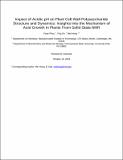| dc.contributor.author | Phyo, Pyae | |
| dc.contributor.author | Gu, Ying | |
| dc.contributor.author | Hong, Mei | |
| dc.date.accessioned | 2021-09-20T17:30:13Z | |
| dc.date.available | 2021-09-20T17:30:13Z | |
| dc.date.issued | 2018-10-24 | |
| dc.identifier.uri | https://hdl.handle.net/1721.1/131772 | |
| dc.description.abstract | Abstract
Acidification of plant primary cell walls causes cell wall expansion and plant growth. To understand how acidic pH affects the molecular structure and dynamics of wall polysaccharides, we have now characterized and compared Arabidopsis thaliana primary cell walls in neutral (pH 6.8) and acidic (pH 4.0) conditions using solid-state NMR spectroscopy. Quantitative 13C solid-state NMR spectra indicate that the pH 4.0 cell wall has neutral galacturonic acid residues in homogalacturonan (HG) and rhamnogalacturonan (RG). 13C INEPT spectra, which selectively detect highly dynamic polymers, indicate that some of the HG and RG chains in the interfibrillar region have become more dynamic in the acidic wall compared to the neutral cell wall, whereas other chains have become more rigid. Consistent with this increased dynamic heterogeneity, C–H dipolar couplings and 2D 13C–13C correlation spectra indicate that some of the HG backbones are partially aggregated in the acidic cell wall. Moreover, 2D correlation spectra measured with long mixing times indicate that the acidic cell wall has weaker cellulose–pectin interactions, and water-polysaccharide 1H spin diffusion data show that cellulose microfibrils are better hydrated at low pH. Taken together, these results indicate a cascade of chemical and conformational changes of wall polysaccharides due to cell wall acidification. These changes start with neutralization of the pectic polysaccharides, which disrupts calcium crosslinking of HG, causes partial aggregation of the interfibrillar HG, weakens cellulose–pectin interactions, and increases the hydration of both cellulose microfibrils and matrix polysaccharides. These molecular-level structural and dynamical changes are expected to facilitate polysaccharide slippage, which underlies cell wall loosening and expansion, and may occur both independent of and as a consequence of protein-mediated wall loosening.
Graphical abstract | en_US |
| dc.publisher | Springer Netherlands | en_US |
| dc.relation.isversionof | https://doi.org/10.1007/s10570-018-2094-7 | en_US |
| dc.rights | Creative Commons Attribution-Noncommercial-Share Alike | en_US |
| dc.rights.uri | http://creativecommons.org/licenses/by-nc-sa/4.0/ | en_US |
| dc.source | Springer Netherlands | en_US |
| dc.title | Impact of acidic pH on plant cell wall polysaccharide structure and dynamics: insights into the mechanism of acid growth in plants from solid-state NMR | en_US |
| dc.type | Article | en_US |
| dc.contributor.department | Massachusetts Institute of Technology. Department of Chemistry | |
| dc.eprint.version | Author's final manuscript | en_US |
| dc.type.uri | http://purl.org/eprint/type/JournalArticle | en_US |
| eprint.status | http://purl.org/eprint/status/PeerReviewed | en_US |
| dc.date.updated | 2020-09-24T20:37:30Z | |
| dc.language.rfc3066 | en | |
| dc.rights.holder | Springer Nature B.V. | |
| dspace.embargo.terms | Y | |
| dspace.date.submission | 2020-09-24T20:37:30Z | |
| mit.license | OPEN_ACCESS_POLICY | |
| mit.metadata.status | Authority Work and Publication Information Needed | |
